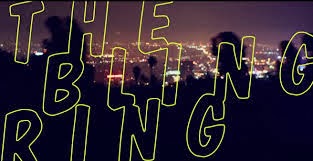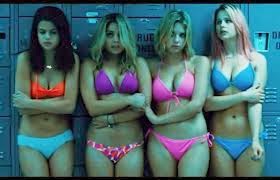ENNUI PARTY FLICK
a consideration of a new genre
By Leah Dubuc
 |
| She's ready to party ennui style! |
I know it may seem like there are an unlimited amount of films about affluent teenagers with no goals in life except to get money, party and be idolized by their less successful peers—the supposed audience for these films. If you think about it, you realize that they’re actually aren’t that many, but after watching a few it feels as if you’ve seen a thousand. 2013 marked the release of two landmark works of a genre one might call, “ennui party flicks”: Harmony Korine’s Spring Breakers and Sofia Coppola’s The Bling Ring.
Both films open the same way: flashy montages
that depict the lavish lives of the not quite charming young, rich and
hedonistic. In the case of Spring Breakers we have big tittied bikini babes on
the beach guzzling Budweiser out of beer bongs and getting their asses grabbed
by buff dudes that are probably failing algebra. But fuck it, bitches, it’s
spring break! What makes Korine’s montage unique is that it’s shot in an
extreme slow motion that recalls Lars Von Trier’s use of Wagner in his recent
Melancholia. Except, of course, that the song is by Skrillex and we’re ready to
vomit five minutes into the film.
 |
| It's disorientating in strange ways |
Coppola’s film opens in a style that is unsurprisingly hers, although her style might as well be credited to her editor, Sarah Flack. It’s a whiz-bang montage of opulence, drugs and indie pop music. With these easy assurances that we’re cool, too, the camera drifts through Louis Vuitton, Christian Louboutin and Diamonds Forever, each shot separated by the flashing of a camera. Thrown into the mix are some Facebook pics of the so-called suspects and shots of them popping’ pills and stealing fur coats from Orlando Bloom’s house. And let’s not forget the obligatory shots of Lindsay Lohan avoiding the paparazzi and Paris Hilton smiling on the red carpet. What we have here is a recipe for a good time and so we sit back, cradle our popcorn and turn off our brains.
After these “Big Bang” montages, each film takes us back to their characters’ humble beginnings: both Korine and Coppola indulge in depictions of the normal or what we might call, before lavishness, bl. Both directors seem to think that if they show us these characters in less privileged circumstances that somehow that might validate them as real people. Fear not, however, because we’re only being educated for about fifteen minutes before the real party begins or in Coppola’s case more like 45 minutes, but she always has been big on art house slow. Regardless it’s not long before crying ensues and someone just wants to go home.
 |
| The View is rich, but the material is not |
In the end though the “Fuck it, we’re rich, we can do whatever we want” mentality prevails. It’s a potent idea in our culture and Korine and Coppola are certainly aware of the way financial hedonism has infiltrated middle and working class mores. One might even claim that both films begin with some kind of moral and ethical consideration of the crazed lives they depict. However, whatever critique might have raised its wobbly head at the outset is thoroughly decapitated by the finish of each film.
In Spring Breakers any kind of moral is a joke—the hot chicks kill the mob boss and drive off into the sunset in their convertible. Dreams come true, spring break forever, bitches! In The Bling Ring, Coppola aims to please and in the process confuses, if not us, more likely her own intentions. Wait, they all have to go to jail? Doesn’t that mean what they did was wrong and you actually have to pay for the lavish crimes you commit, like, even if you’re a member of the upper class? Not so fast: yes, they have to go to jail for a year, but that’s a small price to pay for getting a reality TV show and a feature article in Vanity Fair. Did you forget that money and fame is the goal in the first place? A year in jail seems like a small price and certainly goes faster than four years of college and however many more of graduate school. Anything but fame is for losers.
 |
| Refined and subtle, a kind of cinematic poetry |
One of Coppola’s main issues is her inherent desire as a filmmaker to bring refined subtlety and poetry into every work that she makes. The film seems confused about its own nature: are we in for a raucous good time or a quiet character study and social critique? In the end it reads more like the latter, especially in how Coppola directs her star Emma Watson. She gives lines like, “it was CHILL,” with such self-awareness that she isn’t so much playing a character as she is making a joke.
Now if Coppola’s intention is to make a not-so-subtle social critique of consumer or celebrity culture then that is all fine and good. The film ends with the male lead, Marc, played by Israel Brussard, being interviewed by Vanity Fair and his comments are sharp and interesting: “It’s just kind of awkward that so many people are loving me for something that is so looked down on in society. If it had been something that would have benefited to community or something like that, I’d love it, but it’s just showing America has a sick fascination with the Bonnie and Clyde sort of thing.”
 |
| These shoes were made for stealing |
Ironically, Marc’s comments are much sharper than Coppola’s movie. Do we really need her to preach to us about our vapid, fame obsessed culture in such obvious ways? The Bling Ring is too contemptuous to extend our understanding of what drove these kids to do what they did and so in the end all we get is empty, easy satire. In some ways, they explain themselves with greater acuity than Coppola. People go to a movie like The Bling Ring because they want to have fun, not because they want to be judged for wanting to be in the theater. Coppola wants it both ways: she wants people in the theater and she wants to tell them that they’re dolts for wanting to be, well, like her.
 |
| Come on, let them have fun or eat cake or something! |
Coppola’s fun montages and quiet judgments cannot exist harmoniously and in the end, the film doesn’t push itself far enough in either direction. The Bling Ring becomes a mixed up mess of parties, theft and coke binges on one side and on the other fabulously dressed teenagers quietly sitting around Paris Hilton’s house and wondering if any of them are really even friends at all? It’s a bad mixture of Porky’s and Antonioni. Coppola wants to develop her characters on a deeper emotional level, but at the same time never wants you to forget that they’re vapid and what they did was definitely, definitely wrong, and she is NOT condoning it.
Coppola’s attempt to call attention to America’s fame obsessed nature in the end manages only to fuel it even further. It also seems in a way that Coppola is capitalizing in this same nature as a tool for promoting her film: bangin’ pop songs and shots of jewelry, Facebook pictures, and dancing make up the short trailer. It looks like an amazing exclusive party with Emma Watson, and if you throw down ten dollars to see Coppola’s movie, you can get in on the fun. The film’s advertising piggy-backs on the appeal of celebrity and money culture as a way of selling her work. But as a smart independent director she doesn’t want to be accused of selling out, which is why in the end we have about 60 minutes of quiet reflection, and 20 minutes of good solid partying like she promised.
 |
| This is what's being sold |
Korine’s film was similarly marketed. He’s selling us the chance to see all our favorite virginal Disney stars getting frisky on spring break, and in a way he doesn’t disappoint. There is something oddly charming about watching that chick from high school musical make James Franco suck a gun she’s holding like its her dick. But in a way Spring Breakers leaves you feeling cheated: there are just too many dream sequences of the girls lying in bed saying “spring break forever, bitches” while Salena Gomez calls her grandmother and gets the hell out of the situation? The movie? Her contract? It’s very hard to tell.
The key difference between Korine’s film and Coppola’s is the respect that Korine has for his characters: you can tell as an audience that he liked creating them and he’s having fun with the story. He even manages to try to elevate the things that we as a cultured audience with refined taste would normally find tasteless. One of the most beautiful and memorable scenes in the film is Franco’s soft piano rendition of Britney Spears’s “Everytime,” which will even have your snobby Criterion cousin swooning in trashy ecstasy. Yes, Spring Breakers is definitely sloppy, but there’s something oddly dignified about the way Korine handles his film. These girls don’t get fucked around, and although they’re scantily clad, there’s something progressive about their desires. He even asked the actresses to gain weight, so they’d look more like real people.
 |
| An odd respect for character |
Although the subject matter is crude, and superficially it can be read like Coppola’s commentary, in the end Korine’s film is more heartfelt and daring. He wants his protagonists to succeed just like in a standard film, but wants the audience to question why they’re rooting for these people in the first place. Yes, the characters in Spring Breakers just want to get rich, get drunk and get out, but Korine dignifies them and that makes those goals seem oddly worthy.
 |
| A journey to the heart of a dark country, albeit a day-glow one |
©The CCA Arts Review and Leah Dubuc

No comments:
Post a Comment